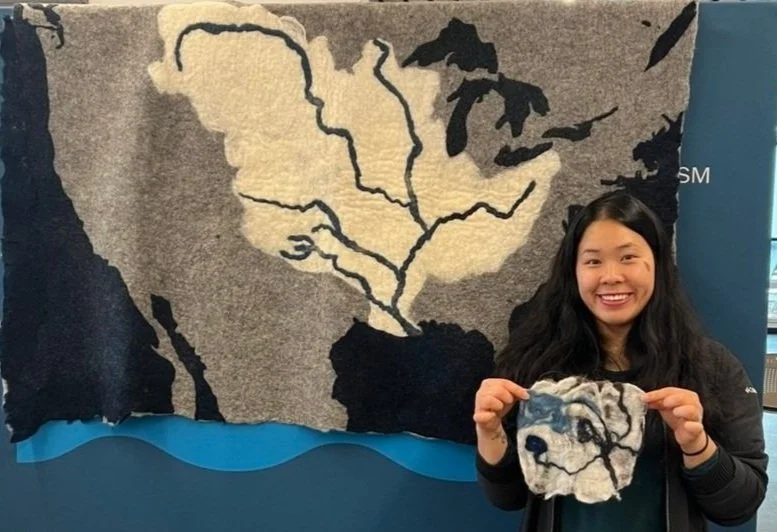Pocket Watersheds
The world’s fourth largest watershed and a pocket watershed participant with her project.
Pocket Watersheds is a FELT EXPERIENCE.
Pun intended! While we can’t see the watershed, here in the Midwest, we live in the world’s fourth largest watershed, one that covers over 40% of the US land area, and one of profound economic, social and historic importance. But the word watershed can be elusive. The Mississippi River Watershed is our home, but how can we envision it, let alone imagine how to care for it? Why is it important to each of us individually, and all of us together?
To get a feel for the way a watershed connects areas of the landscape and all that inhabits it, participants learn to use wool, water and a little soap to hand felt pocket-sized watershed maps. The resulting “Pocket Watershed” is meant to be a handmade brag piece about how “We live in the fourth biggest watershed on Earth!” - an item you pull out of your back pocket as you throw down that knowledge to your neighbors and friends with a big smile. If swagger isn’t your vibe, it’s also a great teaching tool for explaining what a watershed is to another person of any age.
The article below shows that most people living in this awesome mega-watershed region don’t even know it. We learn to envision the shapes of lakes, rivers, mountains and valleys, but we don’t necessarily have a mental map of what a watershed looks like. Our collective imagination is important to caring for our shared ecosystems, and each of us can learn new ways to talk about them and even have fun by creating something unexpected.
WATERSHED DEFINITION
A watershed is an area of land that drains to a single outflow point. Watersheds are nested — smaller watersheds can drain into larger watersheds.
WET FELTING, CLOTH & WATER
Every stage of cloth production requires water. Growing the fibers, preparing them for spinning, weaving and dyeing, and then washing and ongoing care of textiles require water. Wet felting is among the most ancient forms of cloth making. Water, soap, agitation and pressure cause wool fibers to slide and interlock in a mat that becomes denser the longer it is felted.
The clothing we wear is a direct connection to waterways around the world - from the faraway factories where fabric is woven and clothing is made, to our local watersheds that absorb our laundry water. Worldwide, the textile industry accounts for 20% of water pollution.
REFERENCE LINKS
Article: “Mississippi River basin residents worry about the environment and want change, study finds. But many don't know they're in the basin.” The Milwaukee Journal Sentinel, Madeline Heim, 10/2023
Report: “Missouri School of Journalism releases major study on environmental attitudes in Mississippi River basin”
Study PDF: Public research in the Mississippi River Basin: Environmental perspective and identity, October 2023
Website: Mississippi River Basin Ag & Water Desk
